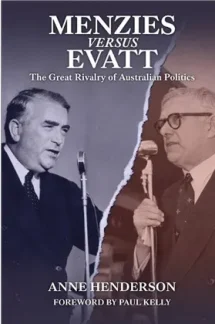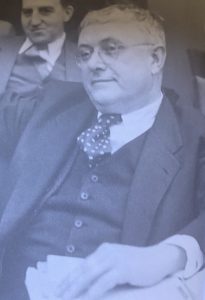Menzies versus Evatt

By Anne Henderson (2023)
Robert Menzies and Herbert Evatt were both born before Australia was – in 1894 to be exact, in the colonies of Victoria and New South Wales respectively, but they would blossom under the soon-to-be-created Federal Commonwealth. Their natural intelligence and Victorian work ethic set them on the path to success, and to some degree, Australia became the better for their struggle, in that they brilliantly represented, and advocated for, different yet necessary principles and practices of the nation’s democracy.
Menzies went to the Victorian bar, and still in short pants lead in the Engineers’ Case (1920), a seminal constitutional decision for federalism, establishing, in Sir Owen Dixon’s words, that under the Federal Constitution, “a power to legislate with respect to a given subject enables the Parliament to make laws which, upon that subject, affect the operations of the States and their agencies.” It was unclear that an award on employers in a certain industry could bind employers in a State that were government instrumentalities. Menzies, opening the batting before the High Court on a case stated, ran the line that the interveners were to be regarded as trading rather than governmental corporations. Justice Stake said this was “nonsense.” With the impetuousness of youth, Menzies replied “Sir, I quite agree.” He submitted that if he was allowed to question and challenge earlier decisions of the Court, he could put a better argument. After retiring for a time, the Court returned, adjourned the case to allow intervention by all concerned States and a full argument, with explicit leave to challenge any earlier decision of the Court. Stirring stuff. Note that Evatt appeared as junior counsel for an opposing party. Later, Menzies entered politics on the conservative side, and became Prime Minister in 1939.
Evatt was no less distinguished. After honourable service to the NSW Bar and State Government, he was appointed (by the financially and intellectually bankrupt Scullin government, but let that pass) to the High Court (aged 36!). A man who, to borrow Gore Vidal’s phrase, lived in a rarified world of theory, he was neither popular on the Court nor a ‘team player,’ and in 1940, he resigned his commission and stood for federal parliament in 1940, in the seat of Barton, winning by a handsome margin.
There had been some previous desultory exchanges between them, but from the time of Evatt’s election, the pair found themselves in the political sphere, destined to become mortal enemies. In this compelling book, the author traverses the events whereby these two brilliant, dedicated and proud men came into war with each other, creating firestorms that sucked much oxygen out of public discourse for at least twenty years. In the final analysis, Evatt, whilst perhaps the genuine genius of the pair, lost the war because he bit-off more than he could chew, he was chronically disorganised and lacked the trust to delegate, he pursued an ideology already proved as far too altruistic for humans, and his unique talent for personal relationships made adversaries of those that could have been friends. He was also, near the end, probably certifiable, surely paranoid at the very least.
Henderson concentrates on the Big Issues where battlelines were drawn. First, the election of John Curtin in 1941 (when Evatt became both Attorney-General and External Affairs Minister: a staggeringly burdensome remit – think of Mark Dreyfus and Penny Wong in the one person – or wait, forget that – bad example). Then, Evatt’s conduct of Prime Minster Chifley’s idiotic push to nationalise Australia’s banks. WWII having concluded, undeclared WWIII started, and the Cold War covered Menzies, and especially Evatt, with its umbra. In a sense, Evatt was a man out of time by 1949: his sterling but sterile work with the United Nations, where he created a path to Universal Rights deemed essential post-Hitler, was rendered otiose by the Soviet Union’s invention of Universal Misery. His last, great, and stylish act, to lead the charge to defeat Menzies’ cynical attempt to dissolve the Australian Communist Party by legislation, turned out to be a good intention leading him down to political Hell.
The Australian people tend to be suspicious of government overreach. They turfed-out Chifley’s government over bank nationalisation, a national coal strike, post-war rationing and an ambiguous approach to the iron curtain. But then Menzies arguably stepped over the line himself. He sought to banish the Australian Communist Party, by legislation, and if this failed, by Constitutional change. One suspects that, like the Abba song, he felt he would win if he lost. For though Evatt opposed the bill, Menzies was re-elected in 1951; though Menzies lost the 1951 referendum to ban the ACP, the result was to tar Evatt as ‘soft on communism,’ split the Labor Party and consign it to the wilderness for 23 years.
Let’s take some samples from Anne Henderson’s book as to these issues:
“Once in the position of prime minister a second time. lessons learned over decades saw Menzies become a careful strategist…believing in a style of delegation that left his minsters free to deal with their departments without interference. By contrast, Evatt was a chaotic manager…He expected to be central to all business.”
“While recognising Evatt’s achievements and the energy he expended in this, Hasluck found Evatt to be “emotionally simple and intellectually complex”…”
“In the heat of battle, so to speak, Menzies and his colleagues had not considered the extent of the (CPA ban) bill’s assault on, possibly, ordinary Australians…Menzies was forced to advise the House of Representatives on 9 May that among the list of 53 communist union officials he had given names for in a speech to parliament on 28 April there were five persons who were not communists.” (Reversing the onus of proof is always attractive to the persecutor, but likely to cause injustice).
When Evatt appeared before the High Court in the Bank Nationalisation case, he started off by asking two of the judges to recuse themselves because their relatives had bank shares. And though he then addressed the Court, ponderously and in his usual shrill voice, for 18 days, as David Marr observed, quoted in the book, “He was returning to the High Court which had been happy to see him go seven years before and the animosities had not subsided with time.” (The following year, 1949, Evatt bent the ear of the Privy Council for 22 days – to no effect).
Menzies told a journalist, ahead of the 1954 election: “I would leave politics this 1954 but for Dr Evatt. He’s a menace to Australia and he must be kept out of office by hook or by crook.”
Evatt’s promises to anti-communist Catholic power-broker B.A. Santamaria “…was a shopping list to die for among Movement supporters but it did not fool Santamaria who felt it rather disgusting and went home and told his wife he had met a man without a soul.”
Labor was tipped to win the 1954 election but Menzies, it was claimed, pulled ‘2 rabbits out of the hat’: first, he hosted the newly crowned Elizabeth in February and March 1954. And then, there was the Petrov affair. Vladimir Petrov, Consul at the Soviet Embassy in Canberra, had defected and Menzies took the opportunity, while Evatt was out of town, to announce an espionage Royal Commission: two classic ‘wedges”, even though it seems Menzies may not have planned it so neatly. Henderson writes: “…after three days of strongly supporting the government’s stand on Petrov and the commission…Evatt launched an attack on Menzies…which accused the PM of “sly insinuations” and “making a crude attempt” to disparage the previous administration’s Security service handling.” The economy had picked up and that played to the Liberal’s strength. But it would be hard to discount the effect of the photo, prominently published, of a distraught Mrs. Petrov (one shoe missing), being hustled to a plane at Mascot airport by Soviet goons.
Evatt made things much worse in the wake of the Petrov affair. When the Royal Commission gathered speed, it was revealed that several of his staff had been involved in Soviet shenanigans. And then Evatt decided, in August 1954, to appear before the Commission as counsel. He should have kept a 1,000 miles away. His splenetic, paranoid and bizarre performance was seen as evidence that he was having a nervous breakdown, “shouting his conviction that the documents in the case [were] concoctions.” The Commission removed him as an advocate. Henderson cites Ligertwood J stating: “I have read all the documents, the Moscow letters and any other relevant material and, I repeat, every one shows how fantastic is the allegation that they were forged for the purpose of injuring the Labor Party of Australia.” “The other justices immediately concurred.” Then Evatt ‘doubled-down’ and spoke at length in the Parliament, again ventilating his conspiracy theory. Menzies played him on the break, replying mildly (but lethally) that the House had just witnessed a “very uncommon privilege…[to having] heard counsel who has unsuccessfully advanced certain arguments before a tribunal have the opportunity to advance them for a second time before a tribunal which has not heard the witnesses and has not read the detailed evidence…That is something I cannot remember in my fairly long experience of public affairs.”
Then Evatt, seeking evidence relevant papers had been fabricated, wrote in 1955 to what he thought an impeccable source as to their dubious provenance: Soviet Foreign Minister Vyacheslav Molotov. Enough said.
It would have been an appropriate ‘Beria Moment’ for the Labor Party to have had Evatt metaphorically executed, especially when he called for the expulsion of a subversive element – Victorian Catholics, treacherous anti-communists or ‘traitors’ as he called them. A dumb, fascistic move, revealing an authoritarian streak that had previously broken from cover only occasionally. Henderson speculates on whether Deputy Arthur Calwell could have calmed matters, or knocked Evatt off. Fred Daly, that classic insider, was scornful of Calwell: “pathetic…hesitant, uncertain and waiting for Evatt’s job”. The Victorian branch of the party was purged, a fatal schism was created, which in the author’s view, was brought about because Evatt was at base, “an intense secularist,” anti-Catholic more than anti-communist, a naive internationalist who forgot, or never learned, that politics is above all local.
After more election defeats, where the party still could not bring itself to defenestrate its “brilliant boy,” Evatt was offered a slot as Chief Justice of the NSW Supreme Court by State Labor, whereupon he left the political stage in 1960. But Menzies, perhaps remembering his undertaking to keep Evatt out of power ‘by hook or by crook,’ may not have relaxed his vigil totally until Evatt died in November 1965. Menzies retired as PM in January 1966.
Leave a comment...
While your email address is required to post a comment, it will NOT be published.








0 Comments